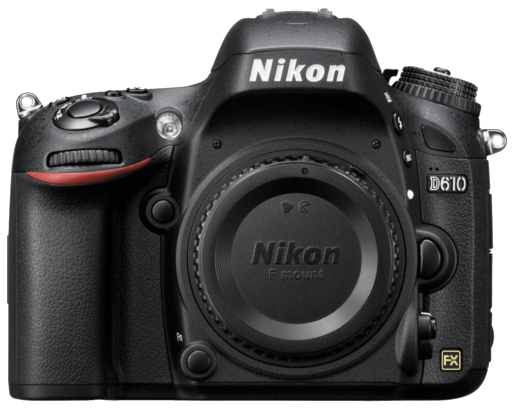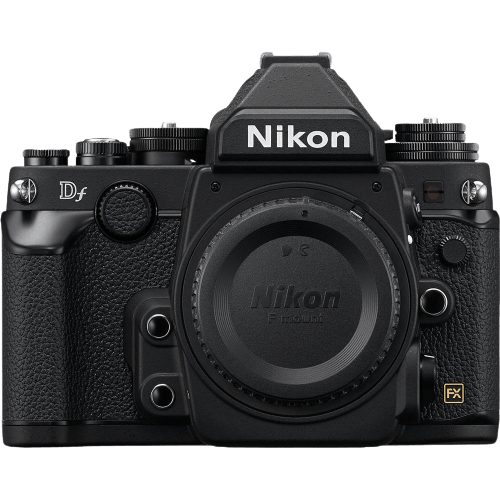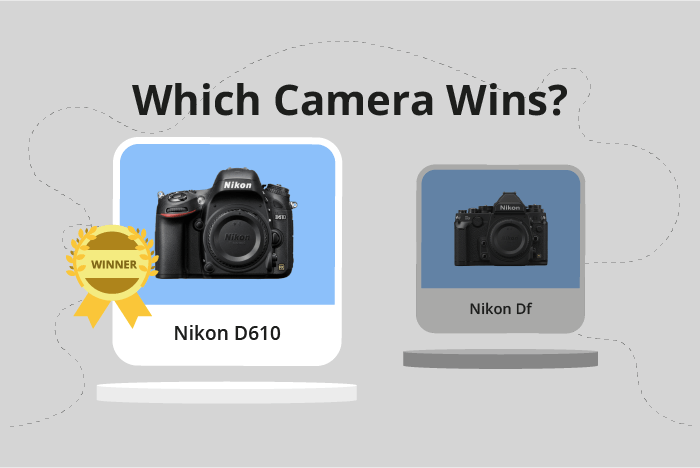Nikon D610 vs Df Comparison
Nikon D610

Nikon Df

The Nikon D610 outperforms the Nikon Df with a score of 66/100 compared to 58/100. Both cameras are DSLRs released in 2013, with the D610 priced at $1999 and the Df at $2749. They share similar dimensions, with the D610 measuring 141 x 113 x 82mm and weighing 850g, while the Df measures 144 x 110 x 67mm and weighs 760g.
The D610’s higher score highlights its superior performance, offering better value for its lower price. On the other hand, the Df has a slight advantage in terms of size and weight, making it more portable and easier to handle. However, this difference is not significant enough to justify the higher price tag.
Taking these factors into account, the Nikon D610 is the better choice for most photographers, offering better performance at a more affordable price, while the Nikon Df’s only advantage is its slightly smaller size and lighter weight.
Nikon D610 vs Df Overview and Optics
The Nikon D610 outperforms the Nikon Df in optics with a score of 70/100 compared to the Df’s 60/100. Both cameras share several specifications, including a CMOS sensor, Expeed 3 processor, full-frame sensor size, Nikon F FX lens mount, and no image stabilization. However, there are notable differences in megapixels, shooting speed, and DXOMARK scores for the sensor.
The Nikon D610 has a higher megapixel count at 24, while the Nikon Df has 16.2 megapixels. This difference allows the D610 to capture more detail and produce higher resolution images. Additionally, the D610 has a faster shooting speed of 6 frames per second, compared to the Df’s 5.5 frames per second. This enables the D610 to capture fast-moving subjects more effectively.
Moreover, the Nikon D610 has a higher DXOMARK score for the sensor at 94, compared to the Df’s score of 89. This indicates that the D610’s sensor performs better in terms of dynamic range, color depth, and low-light performance.
On the other hand, the Nikon Df has its own advantages. Its lower megapixel count can result in better low-light performance and reduced noise at higher ISO settings. This might be preferable for photographers who prioritize low-light shooting over high-resolution images.
Comparing these points, it is evident that the Nikon D610 is superior in terms of optics, with better resolution, shooting speed, and sensor performance. However, the Nikon Df may still be a viable option for those who prioritize low-light capabilities over high-resolution images. Ultimately, the choice between these two cameras depends on the specific needs and preferences of the photographer.
Nikon D610 vs Df Video Performance
When comparing the Nikon D610 and the Nikon Df, it is important to note that the Nikon Df does not have any video functionality. This means that if video recording is a priority for you, the Df may not be the right choice. On the other hand, the Nikon D610 offers video capabilities that could be suitable for your needs.
The Nikon D610 has a video score of 57 out of 100. This camera can record Full HD videos with a maximum resolution of 1920 x 1080 pixels. The maximum video frame rate for the D610 is 30 frames per second. Additionally, the D610 has a built-in time-lapse functionality, which can be useful for capturing events that unfold over an extended period.
To determine the better camera for your needs, consider the importance of video capabilities in your decision. If video recording is essential, the Nikon D610 provides adequate features for capturing high-quality footage. However, if video is not a priority, the Nikon Df may still be a suitable option for your photography needs.
Nikon D610 vs Df Features and Benefits
The Nikon D610 and Nikon Df share an identical feature score of 57/100. Despite the same score, each camera has its own unique set of features that might appeal to different users. Both cameras have a 3.2-inch screen with a resolution of 921,000 dots. Neither camera has a touchscreen or flip screen, and both lack GPS capabilities.
The Nikon D610 has an advantage in connectivity, as it comes with built-in WIFI, while the Df does not. This feature allows the D610 users to transfer files wirelessly and control the camera remotely, making it more convenient for photographers on the go.
On the other hand, the Nikon Df does not have WIFI or Bluetooth capabilities. This may not be a significant drawback for some users, who prefer to transfer files using a cable or memory card.
Both cameras offer similar specifications, but the D610’s WIFI feature sets it apart from the Df. For users who prioritize wireless connectivity, the D610 would be the better choice. However, users who do not require WIFI or Bluetooth may not find any significant differences between the two cameras.
In conclusion, the Nikon D610 and Nikon Df offer comparable features, but the D610’s wireless capabilities give it a slight edge for those who value connectivity. Users who do not require WIFI or Bluetooth may find either camera suitable for their needs.
Nikon D610 vs Df Storage and Battery
The Nikon D610 outperforms the Nikon Df in storage and battery with a score of 71/100 compared to the Df’s 48/100. Both cameras accept SD, SDHC, and SDXC memory cards and lack USB charging capabilities.
The D610 has a clear advantage with its two memory card slots, allowing for greater storage capacity and flexibility. Additionally, its battery life is impressive at 900 shots, powered by the EN-EL15 battery.
On the other hand, the Nikon Df has only one memory card slot, limiting its storage options. However, it surpasses the D610 in battery life, delivering 1400 shots with its EN-EL14 battery.
Considering these points, the Nikon D610 is superior in storage capacity, while the Nikon Df has a longer battery life. Both aspects are important for photographers, and the choice between the two cameras ultimately depends on individual preferences and shooting requirements.
Nikon D610 vs Df – Our Verdict
Are you still undecided about which camera is right for you? Have a look at these popular comparisons that feature the Nikon D610 or the Nikon Df:

